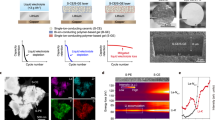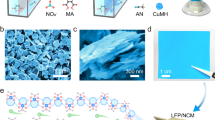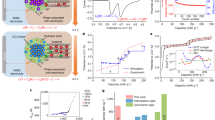Abstract
Classical electrodes for Li-ion technology operate via an insertion/de-insertion process. Recently, conversion electrodes have shown the capability of greater capacity, but have so far suffered from a marked hysteresis in voltage between charge and discharge, leading to poor energy efficiency and voltages. Here, we present the electrochemical reactivity of MgH2 with Li that constitutes the first use of a metal-hydride electrode for Li-ion batteries. The MgH2 electrode shows a large, reversible capacity of 1,480 mAh g−1 at an average voltage of 0.5 V versus Li+/Li∘ which is suitable for the negative electrode. In addition, it shows the lowest polarization for conversion electrodes. The electrochemical reaction results in formation of a composite containing Mg embedded in a LiH matrix, which on charging converts back to MgH2. Furthermore, the reaction is not specific to MgH2, as other metal or intermetallic hydrides show similar reactivity towards Li. Equally promising, the reaction produces nanosized Mg and MgH2, which show enhanced hydrogen sorption/desorption kinetics. We hope that such findings can pave the way for designing nanoscale active metal elements with applications in hydrogen storage and lithium-ion batteries.
This is a preview of subscription content, access via your institution
Access options
Subscribe to this journal
Receive 12 print issues and online access
$259.00 per year
only $21.58 per issue
Buy this article
- Purchase on Springer Link
- Instant access to full article PDF
Prices may be subject to local taxes which are calculated during checkout





Similar content being viewed by others
References
Tarascon, J.-M. & Armand, M. Issues and challenges facing rechargeable lithium batteries. Nature 414, 359–367 (2001).
Tirado, J.-L. Inorganic materials for the negative electrode of lithium-ion batteries: State-of-the art and future prospects. Mater. Sci. Eng. R 40, 103–136 (2003).
Poizot, P., Laruelle, S., Grugeon, S., Dupont, L. & Tarascon, J.-M. Nano-sized transition metal oxides as negative electrode materials for lithium-ion batteries. Nature 407, 496–499 (2000).
Taberna, P-L., Mitra, S., Poizot, P., Simon, P. & Tarascon, J.-M. High rate capabilities Fe3O4-based Cu nano-architectured electrodes for lithium-ion battery applications. Nature Mater. 5, 567–573 (2006).
Bruce, P. G., Scrosati, B. & Tarascon, J.-M. Nanomaterials for rechargeable lithium batteries. Angew. Chem. Int. Ed. 47, 2930–2946 (2008).
Schapbach, L. & Züttel, A. Hydrogen-storage materials for mobile applications. Nature 414, 353–358 (2001).
Seayad, A.-M. & Antonelli, M.-D. Recent advances in hydrogen storage in metal-containing inorganic nanostructures and related materials. Adv. Mater. 16, 765–777 (2004).
Züttel, A. Materials for hydrogen storage. Mater. Today 24–33 (2003).
Sandrock, G. Panoramic overview of hydrogen storage alloys from a gas reaction point of view. J. Alloys Compounds 293–295, 877–888 (1999).
Huot, J., Liang, G., Boily, S., Neste, A. V. & Schulz, R. Structural study and hydrogen sorption kinetics of ball-milled magnesium hydride. J. Alloys Compounds 495, 293–295 (1999).
Fàtay, D., Révész, A. & Spassov, T. Particle size and catalytic effect on the dehydriding of MgH2 . J. Alloys Compounds 399, 237–241 (2005).
Oelerich, W., Klassen, T. & Bormann, R. Metal oxides as catalysts for improved hydrogen sorption in nanocrystalline Mg-based materials. J. Alloys Compounds 315, 237–242 (2001).
Herbstein, F. H. & Averbach, B. L. The structure of lithium magnesium solid solutions. Acta Metall. 4, 407–413 (1956).
Shi, Z., Naik, D. & Gole, J. L. Electrochemical properties of Li–Mg alloy electrodes for lithium batteries. J. Power Sources 92, 70–80 (2001).
Park, M., Kim, Y. U., Kim, H. & Sohn, H. J. Enhancement of the rate capability and cyclability of an Mg/C composite electrode for Li secondary batteries. J. Power sources 158, 1451–1455 (2006).
Larcher, D. et al. Recent findings and prospects in the field of pure metals as negative electrodes for Li-ion batteries. J. Mater. Chem. 17, 3759–3772 (2007).
Tarascon, J.-M. et al. New concepts for the search of better electrode materials for rechargeable lithium batteries. C. R. Chimie 8, 9–15 (2005).
Obrovac, M.N et al. Alloy design for lithium-ion battery anodes. J Electrochem. Soc. 154, A103–A108 (2007).
Tarascon, J.-M., Grugeon, S., Laruelle, S., Larcher, D. & Poizot, P. in Lithium Batteries-Science and Technology (eds Nazri, G. A. & Pistoia, G.) Ch. 7 (Kluwer–Academic, 2003).
Gérard, N. & Ono, S. in Hydrogen in Intermetallic Compounds II Vol. 67, 44 (ed. Schlapbach, L.) 165–195 (Springer, 1992).
Reimann, A.-L. Clean-up of hydrogen by magnesium. Phil. Mag. 16, 673–686 (1933).
Sandim, H. R. Z., Morante, B. V. & Suzuki, P. A. Kinetics of thermal decomposition of titanium hydride powder using in situ high-temperature X-ray diffraction (HTXRD). Mater. Res. 3, 293–297 (2005).
Friedrichs, O., Kolodziejczyk, L., Sanchez-Lopez, J. C., Lopez-Cartes, C. & Fernandez, A. Synthesis of nanocrystalline MgH2 powder by gas-phase condensation and in situ hydridation: TEM, XPS and XRD study. J. Alloys Compounds 434–435, 721–724 (2007).
de Jongh, P. E. et al. The preparation of carbon-supported magnesium nanoparticles using melt-infiltration. Chem. Mater. 19, 6052–6057 (2007).
Haas, I. & Gedanken, A. Synthesis of metallic magnesium nanoparticles by sonoelectrochemistry. Chem. Commun. 1795–1797 (2008).
Acknowledgements
D. W. Murphy and M. Armand are gratefully acknowledged for their enlightening discussions. Moreover, we want to thank L. Dupont for carrying out the TEM study and M. Latroche for providing the AB5H5 sample.
Author information
Authors and Affiliations
Corresponding author
Rights and permissions
About this article
Cite this article
Oumellal, Y., Rougier, A., Nazri, G. et al. Metal hydrides for lithium-ion batteries. Nature Mater 7, 916–921 (2008). https://doi.org/10.1038/nmat2288
Received:
Accepted:
Published:
Issue Date:
DOI: https://doi.org/10.1038/nmat2288
This article is cited by
-
Stress and Manufacturability in Solid-State Lithium-Ion Batteries
International Journal of Precision Engineering and Manufacturing-Green Technology (2023)
-
Critical role of hydrogen sorption kinetics in electrocatalytic CO2 reduction revealed by on-chip in situ transport investigations
Nature Communications (2022)
-
The electrochemical performance of AB5H6 as anode material for lithium-ion batteries
Ionics (2022)
-
Amorphous LiEuTiO4 nanovesicles as a low-operating potential anode for rechargeable lithium ion batteries
SN Applied Sciences (2020)
-
Si/Cu3Si@C Composite Encapsulated in CNTs Network as High Performance Anode for Lithium Ion Batteries
Journal of Wuhan University of Technology-Mater. Sci. Ed. (2019)



